
consociatus head & thorax

consociatus antenna
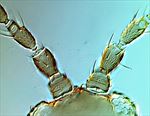
consociatus dorso-apical setae on antennal segment I
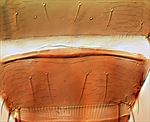
consociatus tergites VII-VIII
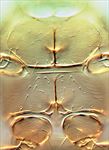
consociatus meso & meta furca
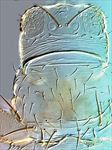
glycines head & pronotum
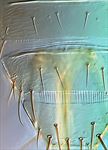
glycines tergites VII-IX

nilgiriensis
female & male antennae

consociatus fore wing
Generic diagnosis
Female macropterous. Head often slightly narrowed to base; maxillary palps 3-segmented; eyes with five usually weakly pigmented facets; mouth-cone sometimes long or even extending to mesosternum; ocellar setae I usually present, setae I and II sometimes absent, setae III long within ocellar triangle; five pairs of postocular setae. Antennae 8-segmented (rarely 7-segmented); segment I with paired dorso-apical setae, III and IV with forked sense-cones, III–VI with some microtrichial rows on both surfaces. Pronotum with two pairs of long posteroangular setae; two pairs of posteromarginal setae. Mesonotum with median pair of setae near or far from posterior margin; campaniform sensilla absent. Metanotum longitudinally or irregularly reticulate; median pair of setae usually at or near anterior margin; campaniform sensilla absent. Fore wing first vein with long gap in setal row, about seven or eight basal and two distal setae, second vein with evenly spaced setal row, posterior fringe cilia wavy; clavus with about five veinal and one discal setae. Prosternal ferna connected weakly at middle; basantra membranous, without setae; prospinasternum broad and transverse. Mesosternopleural sutures weak and not reaching anterior margin; endofurca with spinula. Metathoracic endofurca usually with well-developed spinula. Tarsi 2-segmented. Tergites without ctenidia or craspeda; II–VIII laterally, also laterotergites, with rows of microtrichia, or with scattered dentate microtrichia; tergite VIII with comb long, fine and complete; tergite IX with two pairs of campaniform sensilla, X with or without median split. Sternites without craspeda, often with discal setae; III–VII usually with three pairs of posteromarginal setae, II with two pairs; laterotergites without discal setae.
Male similar to female, but rarely wings absent, antennae in some species 6- or 7-segmented with segment VI much longer than in female with long lateral setae; tergites with fewer microtrichia; sternites with or without discal setae, without pore plates.
Biological data
The species apparently all feed and breed on leaves, although adults can disperse widely onto many plants.
Distribution data
This genus has an extensive distribution around the world. At one time considered essentially Holarctic, many species have now been described extending south across tropical Asia and with two known from Australia and two from Africa.
Nomenclatural data
Mycterothrips Trybom, 1910: 158. Type species Mycterothrips laticauda Trybom, 1910, by monotypy.
There are 37 species listed in this genus (ThripsWik, 2020), and the following eight are recorded from China:
araliae (Takahashi, 1936: 434). (Taeniothrips)
auratus Wang, 1999: 232.
caudibrunneus Wang, 1999: 234.
consociatus (Targioni-Tozzetti, 1887: 425). (Thrips: Euthrips)
glycines (Okamoto, 1911: 221). (Euthrips)
gongshanensis Li, Li & Zhang, 2017: 372.
nilgiriensis (Ananthakrishnan, 1960: 37). (Rhopalandrothrips)
ricini (Shumsher, 1946: 176). (Taeniothrips: Rhopalandrothrips)
setiventris (Bagnall, 1918: 61). (Physothrips)
yelangi Li, Li & Zhang, 2017: 374.
Relationship data
Thripidae sub-family Thripinae: this is a diverse group involving more than 230 genera. This genus is one of only 16 genera from China in which species have a pair of dorso-apical setae on the first antennal segment. However, considering the diversity amongst these genera, including for example genera related to Trichromothrips and genera related to Odontothrips, this character state is not necessarily indicative of monophyly.
References
Li Y, Li Z & Zhang H (2017) Two new species of Mycterothrips (Thysanoptera: Thripidae) from Southwestern China. Zootaxa 4353 (2): 371–377.
Masumoto M & Okajima S (2006) A revision of and key to the world species of Mycterothrips Trybom (Thysanoptera, Thripidae). Zootaxa 1261: 1–90.
ThripsWiki (2020). ThripsWiki - providing information on the World's thrips. <http://thrips.info/wiki/Main_Page>